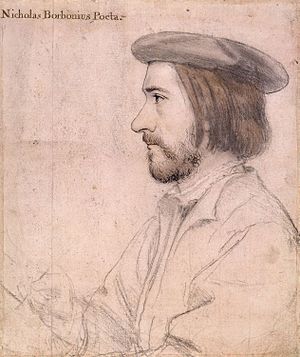Nicholas Bourbon (the elder) facts for kids

Nicholas Bourbon (born in 1503 or 1505, died after 1550) was a French court teacher and poet. He is famous for his collection of poems called Nugae. This Latin word means 'trifles' or 'small things'. In French, the collection is known as Bagatelles. He was the great-uncle of Nicholas Bourbon (1574–1644), who was a member of the Académie française, a famous French language group.
Bourbon was born in Vendeuvre-sur-Barse, France. In 1535, he traveled to England. He went there to thank King Henry VIII of England and his second wife, Anne Boleyn. They had helped him when he faced difficulties in France. Later, Bourbon wrote poems describing Anne Boleyn as one of God's special servants.
His book Nugae was even mentioned in a short, clever poem (an epigram) by John Owen.
Contents
Nicholas Bourbon: Poet and Teacher
Nicholas Bourbon started writing Latin poems when he was young. In an early poem called De Ferraria, he wrote about his hometown, Vandeuvre. This city was known in the 15th century for making cannonballs.
Bourbon also worked as a private teacher, or précepteur. He taught children from important families, including the family of Cardinal of Tournon. He taught subjects like history and literature in cities such as Amiens, Langres, and Troyes.
Early Writings and Challenges
His first poems were published in 1529. This collection was named Vandoperani, campani, epigrammata. It included different types of poems like short, witty verses (epigrams), songs, dialogues, and letters.
In 1533, he released the first edition of his famous book, Nugae (Bagatelles). This book caused problems for him with religious leaders. In one poem, In laudem Dei optimi maximi, Bourbon seemed to support new ideas about religion. People also said his work subtly criticized Noël Béda. Béda was a well-known theologian who disagreed with humanist thinkers. Because of these issues, Bourbon was put in prison for several years.
Even though many of his powerful friends tried to help him, he stayed in prison. A royal order was even given to "take Borbonius out of prison." He also asked Cardinal Jean de Lorraine for help. Finally, King Francis I released him in 1535.
Time in England
After his release, Bourbon went to England. There, he was protected by Anne Boleyn. She had been a lady-in-waiting to Claude of France and was now King Henry VIII's second wife. Anne Boleyn herself supported moderate religious changes. She helped Bourbon find work as a tutor.
While in England, Bourbon was joined by Hans Holbein the Younger. Holbein was a famous painter who was visiting the English Court for the second time. In 1535, Holbein drew a portrait of Bourbon. Bourbon greatly admired Holbein and called him "the Apelles of our time." Apelles was a famous painter from ancient Greece.
Return to France
In 1536, Bourbon returned to France and settled in Lyon. He became a regular member of a group of poets and humanists. This group was loyal to Étienne Dolet and was known as the "école lyonnaise" (the Lyonnaise School). Other members included Jean Visagier, Eustorg de Beaulieu, Gilbert Ducher, and Symphorien Champier.
In Lyon, Bourbon met François Rabelais. Rabelais was another writer who had faced problems with religious leaders for his book, Pantagruel.
In 1538, Bourbon published a second edition of Nugae. This new version had many new poems. However, it had fewer of the controversial letters from the first edition. Around 1540, he became a private teacher for Jeanne d'Albret. She was the daughter of Marguerite de Navarre, a queen and a writer.
Bourbon likely met other famous poets while working for the Queen. One of them was Clément Marot. Marot even included a poem about Bourbon in his book, Adolescence clémentine. The poem was titled "Bourbon, dit Borbonius, poète lyonnais" ("Bourbon, called Borbonius, Lyonnais poet").
See also
 In Spanish: Nicolas Bourbon para niños
In Spanish: Nicolas Bourbon para niños

